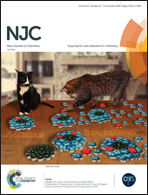New iridium-containing conjugated polymers for polymer solar cell applications
Abstract
A series of novel donor–acceptor (D–A) copolymers P1–P5 with iridium-complexed moieties in their side chains have been synthesized on the basis of a new iridium-containing monomer. The results obtained show that P1–P5 have good thermal stability (317–347 °C) for photovoltaic applications. These copolymers absorb visible light in a broad spectral range up to 680 nm. The optical bandgaps of P1–P5 are in the range of 1.96–2.08 eV, respectively. The HOMO and LUMO energy levels of the polymers P1–P5 estimated from cyclic voltammetry measurements indicate that these copolymers are suitable as electron donors along with PC71BM as an electron acceptor for bulk heterojunction polymer solar cells. BHJ polymer solar cells were developed based on blend compositions (P1–P5):PC71BM. The values of Jsc, Voc, and FF are in the range of 0.95–4.44 mA cm−2, 0.67–0.69 V and 34.6–56.8%, and the power conversion efficiencies (PCE) are in the range of 0.22–1.74%, respectively, the highest value of 1.74% being for P3. Increase of the photovoltaic parameters was achieved with increasing iridium complex percentage in the polymers due to involvement of triplet effects. The improvement in the efficiency of the triplet-forming polymers P2 and P3 in comparison with P1 appears to be due to the formation of triplet excitons in comparison with singlet excitons in the polymer P1 which does not contain heavy metals. With further increase in the content of iridium complex fragments in the polymers, for example, up to 3 mol% for polymer P4, the efficiency falls to 1.23% and further decreased to 0.22% for P5.



 Please wait while we load your content...
Please wait while we load your content...